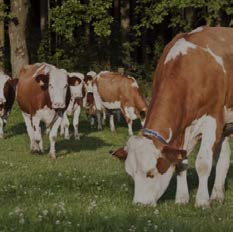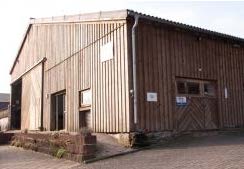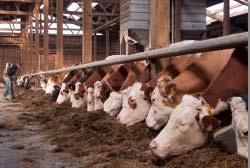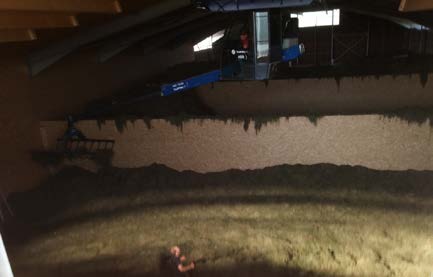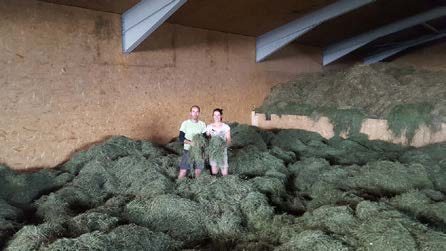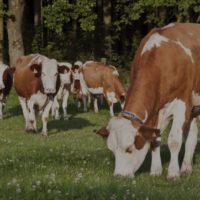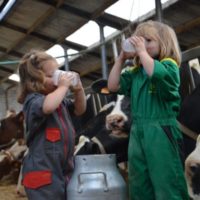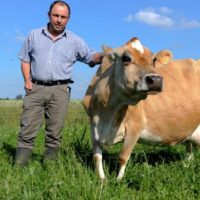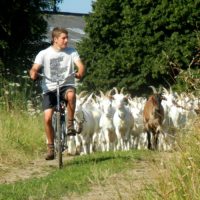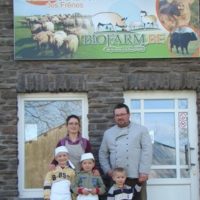Barn drying
Description
Background
The farm is located in Schoppen, a section of the town of Amel in the Eastern part of Belgium. Rainer took over from his father in 1997 and since 2014 he transited to a 100% organic milk production. Today the farm is composed of 116 ha with with 132 Fleckvieh milking cows. He is working on the farm with his wife and a paid worker. In 2002, a new cowshed (wood construction) was built for 100 cows and the old cowshed from 1978 converted into a shed for Heifers. During construction, they have put emphasis on a cost-effective solution and the highest possible comfort for the animals. The milking parlor dating back to 1978 is used for milking the 132 Fleckvieh cows.
In 2002, they also started the breeding of Fleckvieh. The first years they bought a Fleckvieh bull, while continuing to use holsteinsemen in artificial insemination. After the first consistently positive results, they started in 2005 to switch the herd completely to Fleckvieh. Reason was then, on the one hand, the lack of alternative to the extreme breeding (fragility of the Holstein) and on the other hand, the bad calf revenues of the Holstein breed. In search of a dual-use breed, which combines high milk production with a strong and healthy animal, they found the Fleckvieh breed.
Since 2012, they put an increasing importance to seasonal calving. Since 2015, most animals calve from October to April. This is so in order to optimize the grazing (short grass grazing pasture), to organize the working hours better and to leave the calf stable empty for a few months.
The reflections of the farmers to become more efficient, more productive, to lower costs, to lower the workload and to better the quality of the end-product led them to these decisions. The desire to lower the feeding of concentrates, to better the animal health, to produce an end-product with added value that stand out and that is highly desirable by the consumer led them to explore the barn drying system.
Detailed description
In 2017 the farmers have equipped the farm with a barn hay drying system. This installation is working with a condenser, which aim is to dry the air. This is done by cooling it down under the condensation point and warming it up again afterwards. The barn that was built is 60 m long, 22 m wide and is divided in 4 different compartments, each one 1400 m³ big.
The barn hay drying enables to loose less matter on the field and to produce an enhanced hay quality in opposition to hay dried on the field. In principle, the grass is harvested after a first on field drying. This grass is, then, transported to the on farm drying barn, where it is dried and stored. The drying is done through a hot and/or dry air ventilation through the mass of grass.
Mastering barn hay drying requires some expertise. The first step is to harvest the grass at a minimum of 55-65% DM. In our region, it takes 2 to 3 days on the field, in favorable conditions. This system, based on multiple harvests of smaller volume allows more flexibility. Cutting over time also allows staggered regrowth and facilitates grazing management.
Requiring even more expertise and know how is the management of the drying in the barn. The grass has to dry fast enough and in a homogeneous way, but at the same time with low energy consumption. In addition to the 2 days on the field, it takes on average about five more days of drying in the barn. The hay milk allows a simplified very efficient grass-based forage system with a greater autonomy. It reduces harvesting contractor costs, traction and machinery equipment.
There is little data on the economic impact of this technique. Depending on the type of installation and its size, the investment can vary from 200 000 to 1000 000 €. In this particular case, the installation has an investment cost of around 750 000€. On a 20 year basis, with an annual milk production of about 800 000L, this makes around 5 cent/liter of investment costs
Results
The farmer has an efficient management of his forage area. The cost price of the grasslands is only 440 €/ha. This low figure is possible due to the low cost of the equipment. Herd fertility is also excellent (age at first calving 28.9 months, calving intervals: 390 days). The average production per cow is 6200 liters with 4.14% fat and 3.48% protein. The majority of milk is produced through roughage. In 2017, each cow received an average of 750kg of concentrate, compared to 1000kg/cow in 2016. This concentrate is almost exclusively fed during the winter. In summer there is no need for concentrate thanks to the short grass grazing. The average lifetime of the cows on the farm is 6,5 years with an average of calving per cow of 4. Unfortunately, the impact of the barn drying is not yet to be seen fully. Ideally, we would have to look at the numbers in one or two years.
Adoption criteria
To implement this type of innovation it is needed to build the infrastructure and to get it running properly. Secondly, you have to learn the necessary know-how to get a perfect end product. These 2 points are the most difficult regarding the implementation of the innovation.
This drying method has many advantages:
- Reduced forage losses in the field (in comparison to classic hay)
- Better nutritional quality of the grass
- Improvement of palatability and ingestion
- Better forage quality that improves animal health and increases production; or at equivalent production, reduces concentrate consumption
- A milk quality that is ideal for cheese production.
The main criticism of this kind of installation is the very high cost of the initial investment. Moreover this mode of harvest and drying management, which is more technical and more laborious than silage, is not suitable for everyone.
The main recommendations for any farmer interested in this method of drying are:
- Pay particular attention to the design of the installation
- Consider less expensive barn drying systems
- Acquire know-how for the management of the dryer
- Put in place a better valuation of the final product of the exploitation (milk, meat,…)
- Consider the overall direction of the farm in order to maximize the benefits of this method. For example, barn drying is very well adapted to organic production and cheese production.
Future prospects
Aim of the barn hay drying is to produce the same amount of milk with 50% less concentrates (500kg instead of 1,000kg/cow). The farmers expect to achieve at least 5000 liters through roughage feed, increase the longevity of the lactating herd, reduce veterinarian costs by 30% as well as the workload. In addition to that, it is also intended to get 5 cents more per liter milk from cheese production factories. For the moment, the milk is marketed by the Biomilk dairy, currently without any specific added value.
Additional information
| Farming system | organic farming |
|---|---|
| Domains of innovation | forage conservation technique |
| Main types of animal | dairy cattle |
| Country | Belgium |
| Product type | Case study |
| Language | English |

